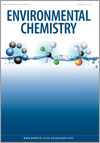EN12136Environmental issues associated with coal seam gas recovery: managing the fracking boom
Environmental context. Coal seam gas reserves are likely to make a major contribution to future energy needs. However, the new technology for exploiting these reserves, termed hydraulic fracturing, raises several environmental issues. We discuss the research required to assess the ecological risks from gas recovery.
EN12136 Abstract | EN12136 Full Text | EN12136PDF (84 KB) Open Access Article




